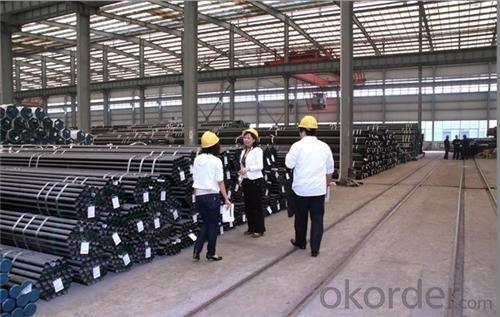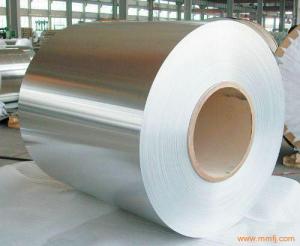Seamless Steel Pipe Cold Rolled/ Cold Drawn
- Loading Port:
- Tianjin
- Payment Terms:
- TT or LC
- Min Order Qty:
- 25 m.t.
- Supply Capability:
- 9000 m.t./month
OKorder Service Pledge
OKorder Financial Service
You Might Also Like
1、Structure of Seamless steel pipe Cold Rolled/ Cold Drawn:
Seamless pipe is formed by drawing a solid billet over a piercing rod to create the hollow shell. As the manufacturing process does not include any welding, seamless pipes are perceived to be stronger and more reliable. Historically seamless pipe was regarded as withstanding pressure better than other types, and was often more easily available than welded pipe.
2、Main Features of Seamless steel pipe Cold Rolled/ Cold Drawn:
• High manufacturing accuracy
• High strength
• Small inertia resistance
• Strong heat dissipation ability
• Good visual effect
• Reasonable price
3、Seamless steel pipe Cold Rolled/ Cold Drawn:
Standard | GB, DIN, ASTM ASTM A106-2006, ASTM A53-2007 |
Grade | 10#-45#, 16Mn 10#, 20#, 45#, 16Mn |
Thickness | 8 - 33 mm |
Section Shape | Round |
Outer Diameter | 133 - 219 mm |
Place of Origin | Shandong, China (Mainland) |
Secondary Or Not | Non-secondary |
Application | Hydraulic Pipe |
Technique | Cold Drawn |
Certification | API |
Surface Treatment | factory state or painted black |
Special Pipe | API Pipe |
Alloy Or Not | Non-alloy |
Length | 5-12M |
Outer Diameter | 21.3-610mm |
Grade | 20#, 45#, Q345, API J55, API K55, API L80, API N80, API P110, A53B |
Standard | ASME, ASTM |
1) Material:20#(ASTM A 106/A53 GRB.API5LGRB,GB),45#,16Mn,10#.
2) Specification range:OD:21.3-610mm,WT:6-70mm,length:6-12m or according to the requirement of clients.
3) Excutive standards:GB,ASME API5L.ASTM A 106/A53,Despite of the above standards,we can also supply seamless steel pipe with standard of DIN,JIS,and so on,and also develop new products according to the requirements of our clients!
4) Surface:black lacquered,varnish coating or galvanized.
5) Ends:Beveled or square cut,plastic capped,painted.
6) Packing:bundles wrapped with strong steel strip,seaworthy packing.
4、Packaging & Delivery
Packaging Details: | seaworthy package,bundles wrapped with strong steel strip |
Delivery Detail: | 15-30days after received 30%TT |
5、FAQ of Seamless steel pipe Cold Rolled/ Cold Drawn:
①How is the quality of your products?
Our products are manufactured strictly according to national and internaional standard, and we take a test
on every pipe before delivered out. If you want see our quality certifications and all kinds of testing report, please just ask us for it.
Guaranteed: If products’ quality don’t accord to discription as we give or the promise before you place order, we promise 100% refund.
②How about price?
Yes, we are factory and be able to give you lowest price below market one, and we have a policy that “ for saving time and absolutely honest business attitude, we quote as lowest as possible for any customer, and discount can be given according to quantity”,if you like bargain and factory price is not low enough as you think, just don’t waste your time.Please trust the quotation we would give you, it is professional one.
③Why should you chose us?
Chose happens because of quality, then price, We can give you both.Additionally, we can also offer professional products inquiry, products knowledge train(for agents), smooth goods delivery, exellent customer solution proposals.Our service formula: good quality+good price+good service=customer’s trust
SGS test is available, customer inspection before shipping is welcome, third party inspection is no problem.
● Professional teams ensure a high efficiency of your purchase
▲ Professional sales team
▲ Professional engineering and technology team
▲ Professional exportation and contract processing/management team
▲ Professional cooperators and partners
6、Seamless steel pipe Cold Rolled/ Cold Drawn Images:


- Q: How can the immersed pipe pile put steel cage into the steel pipe? Which expert to answer?
- The pile reinforcement cage construction characteristics: in general application of the reinforcement cage can be used when not required manual assembling reinforcement cage, such as deep or large pile diameter should be used for solid and solid mechanism of reinforcement cage better (by reinforcing cage seam welder production) to meet Zhuang Jishi high technology requirements, enhance the stability of pile foundation.
- Q: How are steel pipes used in the construction of chemical plants?
- Steel pipes are commonly used in the construction of chemical plants for various purposes. They are primarily utilized for transporting fluids and gases, such as chemicals, water, and steam, throughout the facility. These pipes are selected for their durability, strength, and resistance to corrosion, which is crucial in an environment where exposure to harsh chemicals is common. Steel pipes are also used for structural support, such as in the construction of platforms, walkways, and pipe racks. Additionally, they can be employed for ventilation and exhaust systems, as well as for fire protection systems in chemical plants. Overall, steel pipes play a vital role in ensuring the safe and efficient operation of chemical plants.
- Q: What's the difference between a cracked carbon steel tube and a liquid carbon steel tube?
- If the material is the same, the process is different from the test.
- Q: Are steel pipes suitable for use in sewage treatment plants?
- Yes, steel pipes are suitable for use in sewage treatment plants. Steel pipes are durable, corrosion-resistant, and have a long lifespan, making them ideal for handling the harsh conditions and corrosive substances found in sewage systems. Additionally, steel pipes offer high strength and are capable of withstanding high-pressure flows, making them a reliable choice for sewage treatment plants.
- Q: What is the difference between cast iron and steel pipes?
- The main difference between cast iron and steel pipes lies in their composition and manufacturing process. Cast iron pipes are made from a strong, durable material that consists primarily of iron, carbon, and silicon. They are cast in molds and have a thick, heavy wall. Steel pipes, on the other hand, are made from an alloy of iron and carbon, usually with smaller amounts of other elements. They are manufactured using various methods, such as seamless or welded, and can have different wall thicknesses depending on their intended use. In summary, cast iron pipes are heavier and more brittle, while steel pipes are lighter and more flexible, making them suitable for different applications.
- Q: How are steel pipes used in the telecommunications industry?
- Steel pipes are commonly used in the telecommunications industry for various purposes such as underground cable installation, protection of fiber optic cables, and support of communication towers.
- Q: What are the different types of coatings applied to steel pipes?
- There are several types of coatings applied to steel pipes, including epoxy coatings, fusion-bonded epoxy (FBE) coatings, polyethylene (PE) coatings, polyurethane (PU) coatings, and zinc coatings.
- Q: What are the safety precautions for handling steel pipes?
- When handling steel pipes, it is important to take several safety precautions to prevent accidents and minimize the risk of injury. Here are some key safety measures to follow: 1. Personal Protective Equipment (PPE): Always wear appropriate PPE, including safety glasses, hard hats, steel-toed boots, and gloves. This will protect you from potential hazards such as falling objects, sharp edges, or chemical spills. 2. Proper Lifting Techniques: When lifting steel pipes, use proper lifting techniques to avoid strain or back injuries. Bend your knees, keep your back straight, and lift using your legs instead of your back. If the pipe is too heavy, seek assistance or use mechanical lifting equipment. 3. Secure Storage and Stacking: Store steel pipes in a well-organized manner, ensuring they are properly stacked and secured. Use suitable storage methods, such as racks or pallets, to prevent pipes from rolling or falling. Avoid stacking pipes too high to prevent instability. 4. Inspect for Defects: Before handling steel pipes, inspect them for defects such as cracks, corrosion, or dents. Defective pipes can pose serious safety risks, so it is important to identify and remove them from use. 5. Use Appropriate Handling Equipment: When moving or transporting steel pipes, utilize appropriate equipment such as forklifts, cranes, or hoists. Ensure that the equipment is in good working condition, and always follow the manufacturer's guidelines for safe operation. 6. Secure Transportation: If transporting steel pipes by vehicle, make sure they are properly secured to prevent shifting or falling during transit. Use straps, chains, or other restraints to secure the load. 7. Watch for Sharp Edges: Steel pipes can have sharp edges that can cause cuts or injuries. Be cautious when handling them and wear gloves to protect your hands. 8. Communication and Training: Communicate with your team members to ensure everyone understands the proper handling procedures and safety precautions. Provide training on safe lifting techniques, equipment operation, and hazard identification. 9. Maintain a Clean Work Area: Keep the work area clean and free from debris, oil, or other slippery substances that could cause slips or falls. 10. Follow Safety Guidelines: Always adhere to safety guidelines and procedures established by your organization or relevant regulatory authorities. These guidelines may include additional precautions specific to your work environment. By following these safety precautions, you can significantly reduce the risk of accidents and injuries when handling steel pipes. Remember, safety should always be the top priority in any work environment.
- Q: What is the outer diameter and wall thickness of DN40 steel pipe?
- DN40, refers to the diameter of 40mm, that is, an inch and a half, there are welded pipe and galvanized pipe,Ordinary wall thickness 3.5mm wt 3.84kg/mThicken 4.25mm weight 4.58kg/m
- Q: What are the safety precautions when working with steel pipes?
- When working with steel pipes, it is important to follow certain safety precautions to prevent accidents and injuries. Some key safety measures include wearing appropriate personal protective equipment (PPE) such as gloves, safety goggles, and steel-toed boots to protect against cuts, burns, and impacts. Additionally, workers should be trained on proper handling and lifting techniques to avoid strains and sprains. It is crucial to inspect the pipes for any defects or damage before use and ensure they are properly secured to prevent them from falling or rolling. Finally, maintaining a clean and organized work area, using caution signs, and following proper procedures for cutting, welding, and handling flammable materials are essential for a safe working environment.
Send your message to us
Seamless Steel Pipe Cold Rolled/ Cold Drawn
- Loading Port:
- Tianjin
- Payment Terms:
- TT or LC
- Min Order Qty:
- 25 m.t.
- Supply Capability:
- 9000 m.t./month
OKorder Service Pledge
OKorder Financial Service
Similar products
Hot products
Hot Searches
Related keywords


























